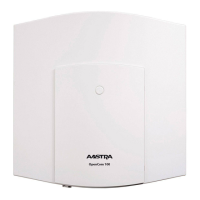Features
14
• SIP (internal): You can operate SIP system phones Aastra 673xi/Aastra 675xi and
standard SIP telephones.
• SIP (external): You can use external SIP connections as “SIP trunk lines”. Setting
up and using external SIP connections is completely transparent for telephone
users, providing them with easy access to low-cost Internet telephony and a
fallback to normal ISDN connections in case of error or busy lines. A Media
Gateway card is required for SIP telephony.
• Q.SIG-IP and SIP tie line: Several communications systems can be networked via
IP connections using “Q.SIG IP”. Low-cost data connections can be used to
network the communications systems of branch offices instead of ordinary per-
manent ISDN lines.
• DECT over IP
®
: DECT networking via VoIP is another possible option for offices
already extensively using VoIP telephony. The Radio Fixed Parts (RFPs) are con-
nected via network data connections, so they do not occupy any U
pn
ports and
can use existing network connections. With DECT over IP, VoIP protocol data is
changed into DECT-compatible voice data direct on the RFPs. DECT-RFPs and
DECT over IP-RFP can be used together in combination in many cases; it is
however not possible to switch between RFPs using different technologies during
a call.
Packet Data in the D Channel
Some business applications, for instance POS terminals, cash registers or credit card
terminals, require a permanent data connection over the X.25 packet data network.
Packet data transfer through the ISDN D channel (according to X.31 via SAPI 16) can
also be established between several S
0
interfaces of the OpenCom 100. Simultaneous
connections are distinguished by means of a TEI (Terminal Endpoint Identifier).
X.31 packet data can be forwarded between two S
0
interfaces (for instance an internal
and external S
0
interface). Equally, data can be forwarded (“routed”) over permanent
Q.SIG lines. Data can also be routed over an S
2M
interface. It is possible to operate mul-
tiple terminals with the same TEI on different internal S
0
interfaces. A TEI mapping
table allows these X.31 connections to be routed to the same external S
0
interface.
The routing table for X.31 packet data is set in the Configurator under Telephony:
Extended: X.31. Additional information can be found in the Configurator online help
files.

